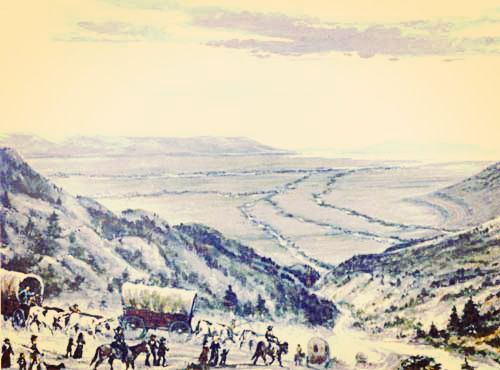When the first company of Saints arrived in the Salt Lake Valley, it was uncertain if crops could be grown in the high, dry climate. Relying on their faith, however, the early pioneers pressed forward, surviving on edible plants and small game until the spring. They quickly set to work planting their crops, which began to sprout up and bring hope to the Saints. However, their hope quickly changed to concern as frost, crickets, and drought quickly destroyed their budding plants.
Eventually, the crickets were destroyed by seagulls, the frost passed, and irrigation ditches provided the ability to watch the parched fields. They quickly replanted, and by the time of harvest, things were looking up. With faith and gratitude that the Lord had preserved them, and likely remembering the Thanksgiving celebrations of those on the East Coast, the Latter-day Saints established Thursday, August 10, 1848, as a day of feasting and thanksgiving for their first successful crops.
Early that morning, a Liberty Pole with a white flag was raised, a cannon was fired, a band played, and those in attendance shouted “Hosannah to God and the Lamb, for ever and ever, Amen.” They sang Parley P. Pratt's “Harvest Song,” danced, and gave speeches.
The highlight of the festivities, however, was the feast.
Seated under a large specially constructed bowery, “As noon approached, a bugle sounded and the hungry crowd rearranged the benches and put dishes and utensils on the tables.” Elder Pratt reported on the delicious foods served at the feast: “We partook freely of a rich variety of bread, beef, butter, cheese, cakes, pastry, green corn, melons, and almost every variety of vegetables.”
Though that initial Thanksgiving celebration was deemed an enormous success, the blossoming population made a city-wide feast too impractical in following years. However, three years later, Brigham Young proclaimed New Year’s Day of 1852 to be a “Day of Praise and Thanksgiving.” His proclamation to the Saints, given on December 19, 1851, instructed them to focus their day on gratitude and praise to the Lord—a time to share with those in need and enjoy a spirit of love. These early pioneer celebrations of gratitude are no longer practiced today, but their guidelines for observing a day of thanksgiving could still be applied to our Thanksgiving celebrations today:
Prepare for the Day
"[...] that they rise early in the morning of the first day of the new year, and wash their bodies with pure water; that all men attend to their flocks and herds with carefulness; and see that no creature in their charge is hungry, thirsty, or cold; while the women are preparing the best of food for their households, and their children ready to receive it in cleanliness and with cheerfulness...."
Abstain from Evil, Contention, and Malice
"I recommend to all the good citizens of Utah, that they abstain from everything that is calculated to mar or grieve the Spirit of their heavenly Father on that day...I also request of all good and peaceful citizens, that they abstain from all evil thinking, speaking, and acting on that day; that no one be offended by his neighbour; that all jars and discords cease..."
Focus Your Thanks on the Lord
"I further request, that when the day has been spent in doing good; in dealing your bread, your butter, your beef, your pork, your turkeys, your molasses, and the choicest of all the products of the vallies of the mountains, at your command, to the poor; that you end the day in the same order, and on the same principle that you commenced it; that you eat your supper with singleness of heart, as unto the Lord, after praise and thanksgiving, and songs of rejoicing..."
You can read Brigham Young’s complete proclamation here.

